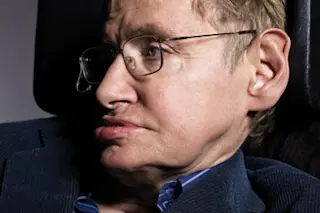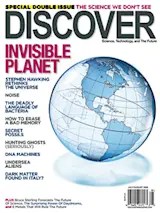Also see "Being Stephen Hawking," the profile of Stephen Hawking by former
Nature editor John Maddox.
Two decades after rocketing to scientific stardom with his book A Brief History of Time, Stephen Hawking still knows how to make an entrance. On a mild March evening in Pasadena, California, 4,500 people fill the convention center to hear him give a talk called “Why We Should Go Into Space.” Shortly after 8 p.m. the lights dim, a few thousand conversations stop, and the soaring trumpet fanfare from Richard Strauss’s Also Sprach Zarathustra (better known as the theme from 2001: A Space Odyssey) fills the room. Hawking is in the house. The crowd turns to watch the frail physicist being wheeled at a good clip down the center aisle. He is wearing a charcoal gray suit and an open-neck white shirt; his head slumps toward his right shoulder; his hands are folded neatly ...















